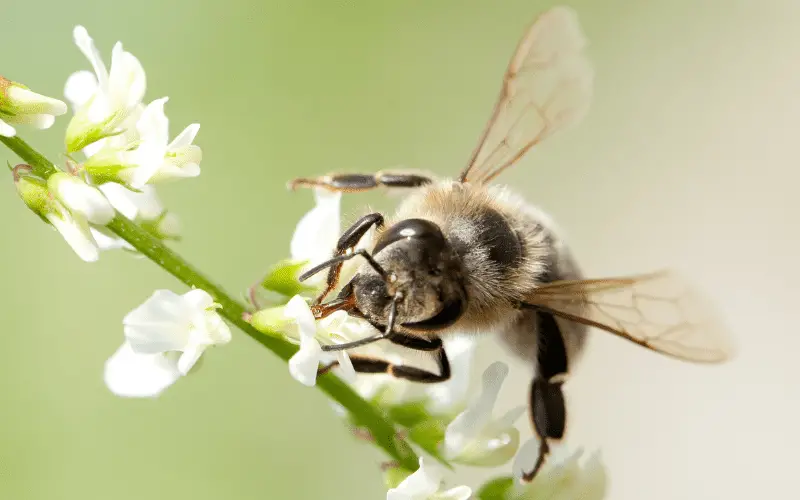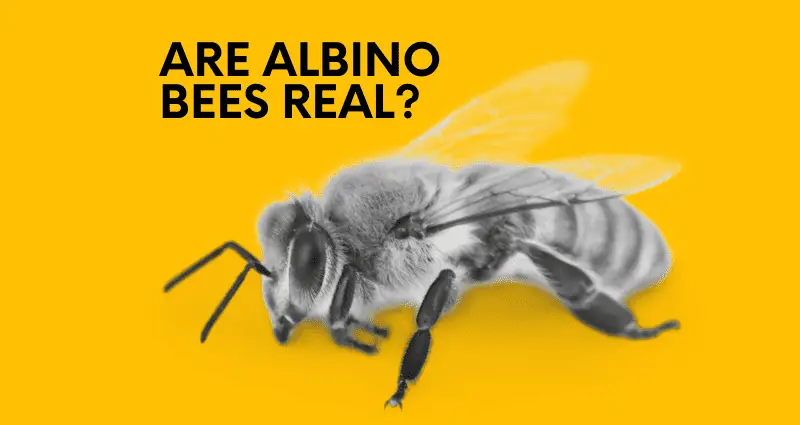The existence of Albino Bees is a contentious debate amongst Apiarists, beekeepers, and the public. This is due to the fact that there are multiple reasons why a bee may look like an Albino bee, but it may not cary the Albino genetic quirk required for it to truly by Albino.
In many beekeeping forums, the term albino bees and their existence is a trending and debatable topic. There is no viable closure regarding these bees’ existence and how they exactly look.
Google images display dissimilar photos of albino honey bees. Some have a black and white striped abdomen, while other pics show fuzzy colored bees. But all these unique characteristics are due to other features besides the genetic quirk.
In this post, we’ll answer whether albino bees exist and provide some background surrounding all this albino bee confusion.
What Is Albinism?
Albinism is a genetic mutation in which the chemical melanin is either diminished or completely absent.
This causes the skin, hair, or eyes to be pale in color.
Both humans and animals are susceptible to this albinism quirk.
Do Albino Bees Exist?
Yes, albino bees can exist.
But, there have been no scientifically verified cases of albino bees.
So, why all the confusion surrounding albino bees?
A Catch-All Term
First, the term “albino” has become a catch-all term to describe pale-colored insects or animals when the common skin, hair, or fur color of that animal is dark.
This may not mean the animal’s melanin is diminished or absent, but simply be an easy way to describe the animal.
For instance, a master beekeeper, during his hive visits, spotted one odd bee with a pair of creamy yellow eyes instead of the typical black eyes. Labeling this mutation as “albino” seemed like the most appropriate descriptor.
Unique Species
Second, there are specific species of bees that can often be mislabeled as albino.
For instance, an individual submitted a photo of a bee to the forum /r/interestingasfuck, asking if it was an albino bee.
The bee was identified as an Ashy Mining Bee. The thorax of the male ashy mining bee is usually covered with grey hair, making them look pale/white in color.
Additional white-colored bees include the white-banded bee, the white digger bee, and the white-haired bee.
Pollen Costume
Third, pollen can often be white instead of the more common yellow hew. Both honeybees and solitary bees collect pollen, often becoming covered in it.
If covered in enough pale white pollen, they may look as though they have an albino mutation.
Historical References
Fourth, a short reference in a book titled “The Beekeeper’s Handy Book”, by Henry Alley, mentions D.A. Pike of Smithburg, Maryland, stating;
“Late in the fall of 1873, I reared a queen (Italian) and allowed her to remain in a colony until the next spring, when I noticed that one-half of her worker progeny were nicely marked Albinos, while the other bees from the same queen showed the markings of pure Italians. From this came the famous Albino bees.”
Their peculiar markings Mr. Pike describes as follows; “About the eyes the color is nearly a purple. They have three distinct yellow bands, then three clear white ones. The wings are finer, and a bright silvery color. Their beauty lies in the very bright and distinct colors of their markings. Their thorax and the under part of the abdomen is thickly covered with white hairs.
The queens are of a bright reddish color, large and beautiful, and are covered with white hair the same as the worker-bee.
The Albino bees are fine workers and very gentle. In fact, their gentleness and honey-gathering qualities are strong inducements for their introduction.”
Baby Bees
And finally, very young bees can appear very light in color, until their exoskeleton hardens. To a beginner beekeeper, baby bees can easily be mislabeled as albino bees.

How Do You Identify Albino Bees
Like other insects, bees have multiple color pigments. To recognize an albino bee, the genetic error is very pronounced, impacting the various color pigments.
It causes the color structure of the bee to look different. In this case, the bee develops a faded standard color.
The genetic mutation may only affect one pigment and leave the other pigments’ production, leading to a minor absence of color. Noticing this slight lack of pigmentation in a bee is challenging, even if you constantly monitor bees with a video camera.
Albinism causes blue eyes in humans, but bees’ eye color becomes whitish or yellowish.
But remember, not every lightly colored bee is an albino bee. A bee with a pure white color or an affluent black and white striped thorax is not an albino bee.


